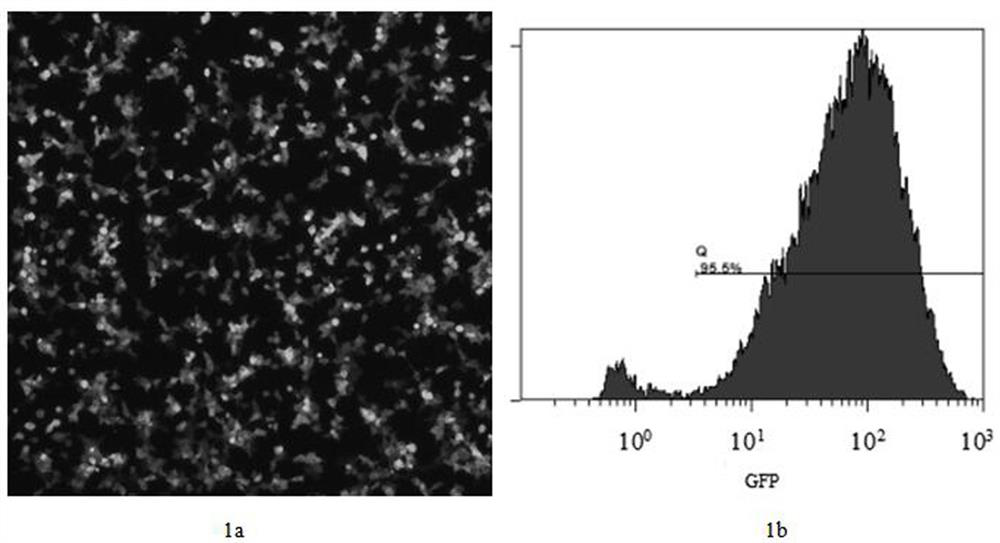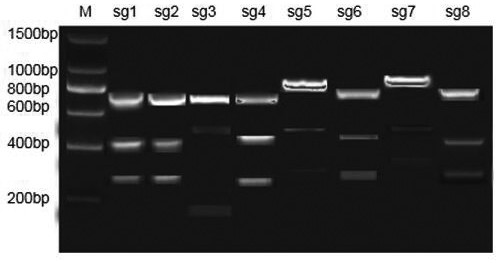Human PD1 gene sgRNA with high knockout rate, plasmid containing sgRNA and T cell
A knockout rate and cell technology, applied in the field of genetic engineering, can solve problems such as no knockout efficiency, no verification of knockout efficiency, unknown knockout efficiency, etc.
- Summary
- Abstract
- Description
- Claims
- Application Information
AI Technical Summary
Problems solved by technology
Method used
Image
Examples
Embodiment 1
[0039] Embodiment 1: for the construction of human PD1 gene Crispr / Cas9 carrier
[0040] 1. Screening for effective sgRNA targets targeting the human PD1 gene
[0041] According to the gene sequence of PD1, design an effective sgRNA target for PD1 gene.
[0042] Table 1 lists 8 effective sgRNA target sequences for the PD1 gene.
[0043] Table 1 sgRNA target sequence of target PD1 gene
[0044]
[0045] 2. Construction of recombinant px458 vector
[0046] The vector selected in this invention is the px458 vector (purchased from Addgene), and each sgRNA sequence in Table 1 was constructed into the px458 vector by conventional methods, and the names of the recombinant vectors are px458-PD1-sg1, px458-PD1-sg1, px458-PD1-sg2, px458-PD1-sg3, px458-PD1-sg4, px458-PD1-sg5, px458-PD1-sg6, px458-PD1-sg7, px458-PD1-sg8.
[0047] In the present invention, 8 recombinant plasmids are purified and concentrated by the cesium chloride method, so that the concentration reaches 1 µg / µL. ...
Embodiment 2
[0048] Example 2: Construction of 293T cells stably expressing PD1 gene
[0049]1. Construction of lentivirus expressing PD1 protein
[0050] The lentiviral vector selected in the present invention is CD513B (purchased from addgene, pCDH-CMV-Nluc-EF1α-
[0051] copRFP-T2A-Puro), the full-length sequence of the PD1 gene coding region (GenBank: AY238517.1) was entrusted to Beijing Biomed Gene Technology Co., Ltd. to synthesize the full-length sequence, and the PD1 gene and CD513B vector were double-digested with XbaI and EcoRI, respectively. Recover the digested product, use T4 DNA to connect the two to form a CD513B vector containing the PD1 gene, named CD513B-PD1, and perform sequencing verification. After correctness, extract the plasmid and remove endotoxin. The CD513B-PD1 plasmid extracted in the present invention The concentration is 600ng / µL.
[0052] 2. Use 293T cells to package lentivirus
[0053] 293T cells were revived and used for transfection after 3 passages; in...
Embodiment 3
[0058] Example 3: Determination of PD1 sgRNA knockout efficiency
[0059] 293T-PD1 cells were treated with 1×10 6 cells / well in a six-well plate and incubated overnight.
[0060] Take 4 μg of the 8 different constructed recombinant px458 vectors containing PD1 sgRNA, mix them with 10 μl FuGENE HD transfection reagent, add DMEM medium to 100 μl, let stand for 15 minutes to form a complex, and aspirate the medium in the six-well plate Drop, add the complex that has stood still, add DMEM medium to 2mL, place at 37°C, 5% CO 2 Culture in the incubator for 6h, replace the DMEM medium containing 10Vol%FBS and continue to culture for 48h, and observe the transfection under the fluorescence microscope (see figure 2 ), collect the cells in one well of each group, and use the FLAG flow cytometry antibody to measure the transfection efficiency; at the same time, the cells in the other two wells are passaged, and the cells in each group are collected 3 days after passage, and the PD1 fl...
PUM
| Property | Measurement | Unit |
|---|---|---|
| Titer | aaaaa | aaaaa |
Abstract
Description
Claims
Application Information
 Login to View More
Login to View More - R&D
- Intellectual Property
- Life Sciences
- Materials
- Tech Scout
- Unparalleled Data Quality
- Higher Quality Content
- 60% Fewer Hallucinations
Browse by: Latest US Patents, China's latest patents, Technical Efficacy Thesaurus, Application Domain, Technology Topic, Popular Technical Reports.
© 2025 PatSnap. All rights reserved.Legal|Privacy policy|Modern Slavery Act Transparency Statement|Sitemap|About US| Contact US: help@patsnap.com



